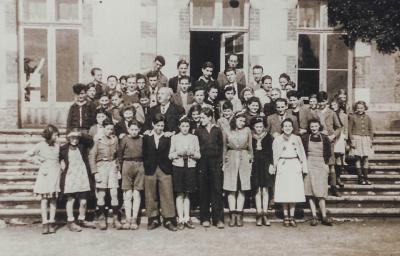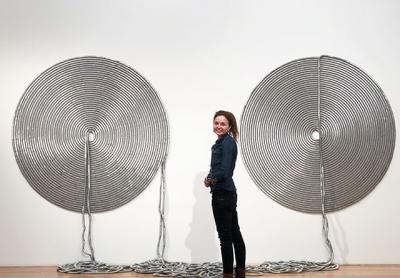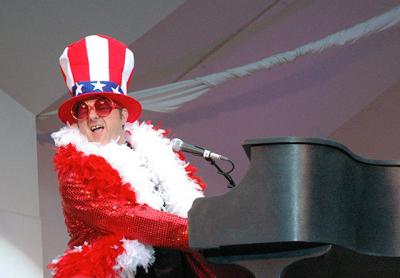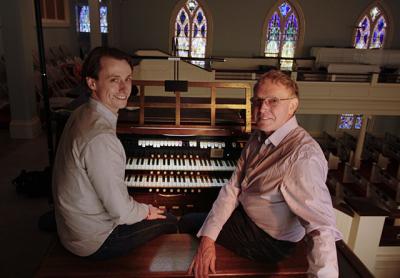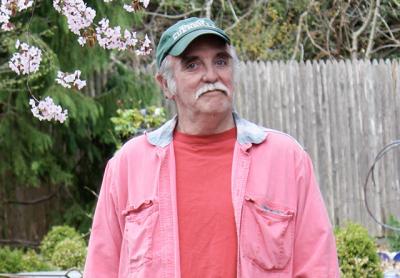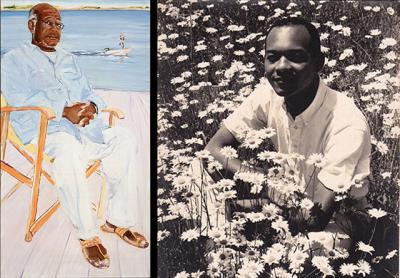A Classic Love Story Set to Teen Heartbeat
A Classic Love Story Set to Teen Heartbeat
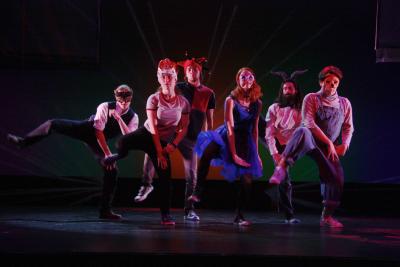
“Romeo and Juliet” was always one of Shakespeare’s most popular works, valued for its romantic intensity. The First Folio print edition, which was chained to a shelf in the Bodelian Library at Oxford University for decades after its publication in 1623, had pages rubbed thin with use by eager readers. The most worn page, it was reported, was the parting of Romeo and Juliet at dawn, when they have consummated their marriage and Romeo must flee into exile.
“Wilt thou be gone? It is not yet near day / It was the nightingale and not the lark / That pierced the fearful hollow of thine ear,” Juliet cries, desperate to convince her lover to stay a while longer.
Precise delivery of such transcendent language that lifts the story to the level of unforgettable, is not always found in the punk love rendition of “Romeo and Juliet” at Guild Hall in East Hampton, which will run through Sunday. Directed by Josh Gladstone, the theater’s artistic director, who also plays the Capulet pere, the revival stays true to the original text while the staging turns the world’s greatest love story into a big, participatory party that is mostly thumping good fun for younger audiences.
High-gloss dance sequences and strobe lighting help keep them engrossed. David M. Brandenburg, a sound designer, has curated an original soundtrack and rock samplings, evocative not just of hormonal teens rutting under foliage, but of the precise era when bands such as the Arctic Monkeys came to the public’s attention via the internet. There are also good, energetic fight scenes and exceptional video projections that transform the John Drew Theater into a graffiti-covered neighborhood, a light-dappled orchard, and even a canvas for emoticon-like images such as beating hearts and doom-spelling skulls.
In addition to Mr. Bradenburg for the music, kudos to Dan Renkin for excellent fight choreography (he also plays Friar Laurence onstage), Kate Mueth, who plays the Nurse too, for her peppy dance choreography, Raye Levine for the scenic and set design, Joe Brondo for his projections and computer graphics, and Sebastian Paczynski for pulling it all together as the technical director. Technically speaking, it’s a stunning achievement.
Emotionally, however, the actors — seven of whom are high school students and as yet to blossom onstage — never quite manage to tease the meaning out of Shakespeare or display a way with the verse that answers its soaring poetry. Lines are mostly hurriedly delivered, as though speaking a foreign language known as Elizabethan English. Incidentally, Shakespeare’s audiences often didn’t know the meaning of words uttered in his plays, since the Bard is credited for inventing over 700 words. Instead, it was the sounds and pictures the locution created that kept viewers enthralled for hours.
But Mr. Gladstone’s “Romeo and Juliet” does connect with adolescents and the importance of this should be noted. Theater for young audiences groans under the burden of its responsibility to keep the future engaged. Shakespeare for young audiences doubles that pressure, requesting an engagement not only with the future, but also with the past. So why bother? Well, for starters, Shakespeare is the only author that America’s public high school students must read, specifically mandated in the Common Core English requirements. American heavyweights such as Hemingway, Twain, and Steinbeck are left to a teacher’s discretion.
Only the smallest of children will be unaware of Shakespeare’s timeless story involving a pair of star-crossed lovers, so this is for them: Romeo Montague (played by Alex Might) drops in on a party held by his family’s arch rivals, the Capulets, and falls instantly in love with a girl, not realizing she is Juliet Capulet, the young lady of the house. His love is returned and the pair vow to marry secretly the next day. But an unfortunate sword fight leaves two young men dead and Romeo is banished because of his crime. This is followed by a faked suicide, a life-or-death message that never arrives, and the quintessential unhappy ending.
At Guild Hall, certain performances deliver the necessary pathos to bring these characters to life. Frankie Bademci, a junior at the East Hampton High School, pulls off a wonderfully funny Peter, the Nurse’s dimwitted servant.
Red-haired and luminously pale, this Juliet, played by 21-year-old Olivia De Salvo, is like a brightly glowing candle amid the strobe lights and techie high jinks. She makes the balcony scene simply touching with an appealing Bambi presence and some good bits of giddy business. She is truly teenage. And until her flame is extinguished in the final scene, it does give a lovely light.
But Charlie Westfal is the show’s most unrepentant scene-stealer as a boisterous Mercutio, all swaggering laddishness. While several of the cast seem doomed by the diction, Mr. Westfal’s performance as Romeo’s cousin is confident and committed to the point where he is missed after his exit from the story.
According to Gregory Doran, the artistic director of the Royal Shakespeare Company in England, when actors deliver Shakespeare’s language with passion and engagement, even children who may not pick up every word can follow a story and be transported.
If that’s true, it’s a shame that engaging the young in this production had to come at the expense of entertaining the more seasoned. But any attempt to please both age groups is eradicated in the first half when Ms. Mueth as the Nurse walks up to the audience and asks, “What’s his name?” pointing to Romeo who has just exited. “Oh come on,” she scolds the adults, who are too busy cringing to answer, “we’re an hour into the show and you don’t even know who the play is about?”
Guild Hall’s “Romeo and Juliet” lasts almost three and a half hours, including a 15-minute break, and it was reassuring that the dozen or so school-age children in the audience on Friday seemed captivated enough by the energy and good fun of it all. According to their parents, none asked to leave midway and were genuinely happy to stay and feel the love. The same was not true for the adults; several disappeared for good during the intermission.
“Romeo and Juliet” plays at Guild Hall tomorrow through Sunday at 7 p.m. Tickets cost $25, $23 for members, and $10 for students.

